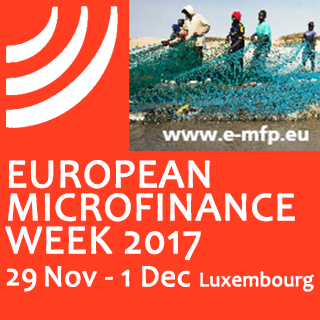At European Microfinance Week on Thursday, Ken Lohento of the Netherlands-based Technical Center for Agricultural and Rural Cooperation described successes engaging youth in agriculture through technology, even those with limited literacy. This can take the form of business tools to track spending or marketing as well as apps that help with pest management, for example. Even older “feature phones” can be used to receive information on markets and tips to optimize production. Among other efforts, Mr Lohento cited Agribusiness TV, which provides mobile-optimized video examples of youth profiting from agriculture, and a service in Senegal that connects owners of underused land with young people looking for acreage to till.
Ken Lohento of the Netherlands-based Technical Center for Agricultural and Rural Cooperation described successes engaging youth in agriculture through technology, even those with limited literacy. This can take the form of business tools to track spending or marketing as well as apps that help with pest management, for example. Even older “feature phones” can be used to receive information on markets and tips to optimize production. Among other efforts, Mr Lohento cited Agribusiness TV, which provides mobile-optimized video examples of youth profiting from agriculture, and a service in Senegal that connects owners of underused land with young people looking for acreage to till.
Dr Jonathan Agwe of the UN’s International Fund for Agricultural Development (IFAD) stated that youth rarely are motivated to engage in the planting and weeding of primary agriculture. “Certain elements of the value chain are more interesting to youth than others,” he said. Youth are more interested in secondary activities that are less labor-intensive, such as using machinery to process crops or vehicles to get products to market. Dr Agwe suggests first “locating a market that is paying premium prices” and then recruiting youth to exploit that opportunity. His experience is that simply encouraging youth to get into agriculture often results in them – if they respond at all – planting what their parents grew. This often fails to be sufficiently lucrative.
Rahul Antao, also of IFAD, described supporting Senegalese youth with market access for activities such as brokering sesame. When local lending institutions weren’t interested the project, IFAD financed 80 percent of it in year one, 60 percent in year two and 40 percent in year three. By year four, the local lenders were ready to fund the operation, which grew to serve 16,000 youth. For recruiting, Mr Antao suggested working through existing groups such as sports clubs.
Mr Antao also described the work of the Slow Food Youth Network (SFYN), which “promotes small-scale agriculture, protects biodiversity and fights food industry’s politics of endless growth” through chapters in 41 countries. Among other programs, it seeks markets for underused plants to encourage biodiversity.
Yves Moury of Colombia-based Fundacion Capital, argued, “The future is digital. The whole development industry will be disrupted.” He said that the use of automated teller machines and agents is ebbing and that cash will be used very little within five to 10 years. In terms of services, he said “credit is not the main bottleneck” for youth. “They need access to savings, transfers, insurance; but credit is for maybe 5 percent of youth.” To encourage savings, he suggested subsidies. Citing the lack of controversy in subsidizing public schools, “if we want young people to save, we should give them accounts and matching deposits” of perhaps 50 cents per dollar saved. Mr Moury also stressed the importance of ideas that be scaled up, pointing out that we need hundreds of millions of jobs.
Regarding keeping youth engaged over time, Dr Agwe argued that youth need handholding such as graduation programming. If all you do is give a person a loan, they may disappear. Instead they should get wrap-around services and write commitment letters to the programs they are in. Perhaps there should be some type of penalty if they leave program before completing it. Several panelists expressed agreement.
Marie Joseph Medzeme Engama of Cameroon-based Plateforme Régionale des Organisations Paysannes d’Afrique Centrale (PROPAC) agreed with the other panelists on common barriers such as the lack of infrastructure, land, access to technology and knowledge of production techniques. As a success story, she described a cassava cooperative in Cameroon that packages, exports and manages local distribution of products such as flour, starch and chips. In addition to adding value to the products, she cited the identification of the market demand before choosing the crop as key to success. The effort boosts the income of 100 members.
As a barrier to success, Ms Medzeme Engama cited lack of finance for processing machinery. A member of the audience argued that leasing is needed to help improve access to such equipment.
Mr Lohento agreed with Ms Medzeme Engama that infrastructure is another critical barrier. To help youth in rural areas to be successful, he said we need better transportation, jobs, communications and business incubators.
This interview is part of a sponsored series on European Microfinance Week, which was held in Luxembourg from November 29 through December 1. MicroCapital was engaged to promote and cover the event on-site.
Sources and Additional Resources
European Microfinance Week 2017
http://www.e-mfp.eu/european-microfinance-week-2017/information
MicroCapital Coverage of European Microfinance Week Since 2012
https://www.microcapital.org/category/european-microfinance-week/
Similar Posts:
- MICROFINANCE PAPER WRAP-UP: “Assessing the State of Youth Financial Inclusion in Developing Contexts,” by Niclas Benni, Published by FAO
- SPECIAL REPORT: How to Achieve Responsible Digital Financial Services: European Microfinance Week Opens
- SPECIAL REPORT: Digitizing Microfinance to Meet Customer Needs via an Incremental Approach #EMW2023
- SPECIAL REPORT: Fintechs vs MFIs – a Debate at European Microfinance Week
- SPECIAL REPORT: Sounding Alarm Bells on Financial Health: Inclusion Is Not Sufficient
